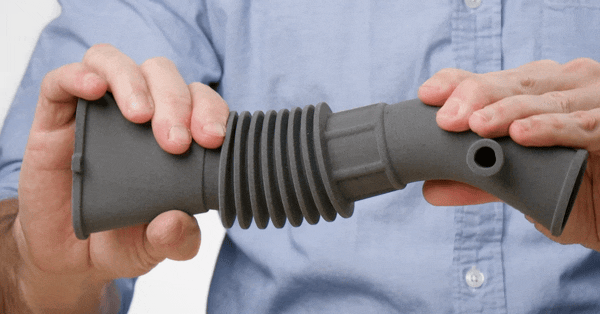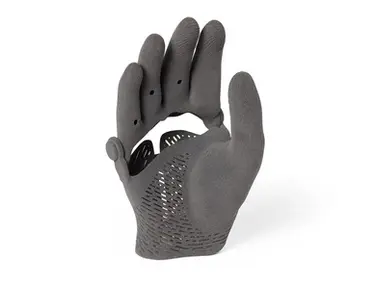Why Choose TPU 90A?
Produce resilient, biocompatible parts with excellent tear strength and elongation at break.
TPU 90A is a high-performance elastomer that combines strength, flexibility, and skin safety. It enables the production of prototypes and functional parts that can withstand repeated stress, impact, and daily use. Common applications include medical wearables, protective housings, gaskets, seals, and consumer products where both toughness and comfort are essential.
3D printing technology
Resolution
0.025 mm (25 μm), ±0.15–0.3%
Maximum print size
130 × 180 × 340 mm (5.1 × 7.1 × 13.3 in)


TPU 90A offers a balanced Shore hardness of 90A, giving it the toughness required for industrial components while retaining the elasticity needed for skin-contact devices and consumer products. Its biocompatibility and superior tear resistance make it especially valuable in applications where both comfort and resilience are critical.
From wearables and seals to industrial tubing and gaskets, TPU 90A delivers consistent, production-ready performance. Parts maintain their flexibility and strength even under repeated bending, stretching, or impact — ensuring long-term reliability across industries.
Key Benefits
-
Biocompatible
-
Functional, strong, isotropic parts with fine detail and dimensional accuracy
-
Excellent design freedom
-
High tear strength and high elongation at break
-
Shore hardness is medium-soft (between pencil erasers and tire treads)
Applications
-
Wearables and soft-touch elements
-
Gaskets, seals, masks, belts, tubing
-
Soles, splints, orthotics, prosthetics
-
Padding, dampers, cushions
-
padding, dampers, cushions and grippers
-
Protective sports equipment

Select Laser Sintering (SLS) printing ensures TPU 90A parts achieve fine detail adn accuracy, as well as excellent tear strength, flexibility, and durability - making it ideal for functional prototypes and end-use components.
Technical Specifications
Accuracy
+/- 0.3% (minimum of +/- 0.3 mm)
Layer thickness
0.075 - 0.175 mm (0.003 - 0.006 in)
Ultimate tensile strength
8.7 MPa/1260 PSI (XY), 7.2 MPa/1050 PSI (Z)
Elongation at break
310% (XY), 110% (Z)
Stress @ 50% elongation
6.1 MPa / 889 PSI (XY), 5.9 MPa / 860 PSI (Z)
Stress @ 100% elongation
7.2 MPa / 1050 PSI (XY), 7.0 MPa / 1020 PSI (Z)
Tear resistance
66 kN/m / 378 lbf/in (XY), 39 kN/m / 247 lbf/in (Z)
Compression Set (23°C)
20.5%
Compression Set (70°C)
59.9%
Shore Hardness
90A
Taber Abrasion
122mm³ / 7 x 10⁻³ in³
Vicat Softening Temperature
94.3 °C / 201.7 °F
Water absorbtion (printed part)
0.89%
Bulk Density (Sintered)
1.14 g/cm³ / 71.2 lb/ft³
Biocompatibility ISO Standards
Samples printed with TPU 90A have passed the requirements for the following biocompatibility risks:
ISO 10993-5: 2009
Non-cytotoxic
ISO 10993-23:2021
Non-irritant
ISO 10993-10:2021
Non-sensitizer
Solvent Compatibility
Refer to the TPU 90a material data sheet for solvent compatibility results. To improve resistance to solvents and improve surface finish we recommend vapor smoothing the part.
Design Guidelines
Max part dimensions
130 x 180 x 340 mm (5.1×7.1×13.3 in)
Min wall thickness
1 mm
Connecting parts
min 0.5 mm between part interface areas
Moving parts
min 0.7 mm between faces of printed assemblies
Embossed / engraved textures
min thickness 0.25 mm
Embossed / engraved text
min line thickness 0.5 mm, depth 1 mm, height 2.5 mm
Design Considerations
-
Consider hollowing or adding internal lattice structure to large solid pieces to improve accuracy and minimize cost.
-
Hinges, sockets, and linked parts can be integrated into the design. Parts that are printed together should have a minimum clearance of 0.5 mm.
-
A minimum wall thickness of 1 mm is recommended. Large parts may require larger wall thicknesses or added ribs or fillets for reinforcement.
-
We advise hollowing out a solid model as much as possible, and when the wall thickness exceeds 20 mm. A wall thickness of 1-2 mm and the inclusion of at least two holes with a minimum diameter of 10 mm for powder removal is recommended.
-
It is possible to create holes or perforations and internal channels. For holes and perforations, the recommended minimum diameter size is 2 mm, but some post-production will be needed to remove excess powder. Longer internal channels can be difficult to clear out, especially if the powder is partially fused together. In general, complex holes or ducts require larger diameters to achieve thorough removal of the unfused powder. We recommend a diameter of at least 3 mm for internal channels. Some residual powder may be stuck on the inside of complex channels. It is advised to design a strip or chain through the channel to help in dislodging the powder once the part has been printed.
-
Lattice structures allow you to modify shock absorption characteristics, as well as to reduce weight and material. A minimum gap of 5 mm between the lattice beams is required so the unfused powder can be removed.
-
For embossed or engraved textures, we advise a minimum thickness of 0.25 mm. For legible engraved or embossed text, we recommend letters with a minimum line thickness of 0.5 mm, a depth of 1 mm, and an overall height of at least 2.5 mm.
Finishes

Raw (gray)
After the part has been printed and has been cleaned it has a powdery gray look and feel. This finish is best suited for functional prototypes and non-visible parts.

Black Dye
Parts are submerged in a hot dye bath containing dye pigment. This gives a smooth, consistent finish with no loss of dimensional accuracy.

Vapor Smoothing
This process uses a chemical vapor that smooths the surface of the part, giving a look and feel comparable to injection molding. Best for consumer-facing parts.






